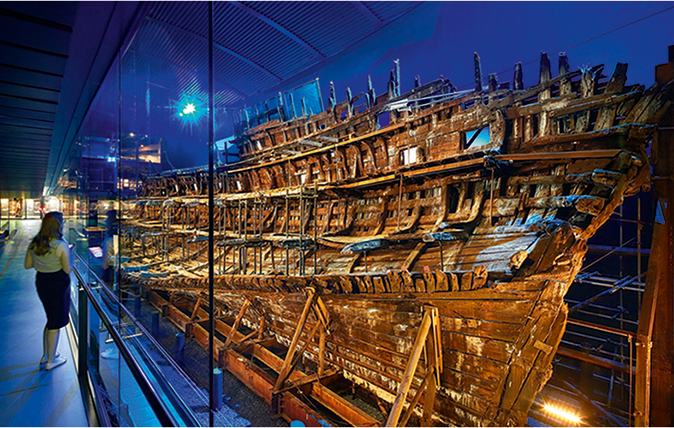The Mary Rose museum review: Prepare to be moved and impressed
Huon Mallalieu re-visits the Mary Rose museum in Portsmouth for the first time since its refurbishment – and suggests we all do the same.


The Mary Rose Museum in Portsmouth Historic Dockyard reopened in July 2016 after a three-year makeover. Anyone who visited it in its previous incarnation, admirable though that was, should return, prepared to be both moved and impressed. There is a particular power to wrecks that rise again.
Those of an age to have been among the 60 million people who, on October 11, 1982, watched what was then the longest-ever television outside broadcast are likely to have forgotten the emotion of the moment when Henry VIII’s flagship, Mary Rose, broke surface after 437 years on the Solent bottom. Swedes similarly remember where they were in 1961 when Vasa was raised.
For 12 years, the timbers had to be constantly sprayed with water, later with a solution of polyethelene glycol, and could only be viewed through mist and glass. Now, one can share the air with the stabilised timbers and seemingly walk the length of the ship’s spine on the levels of three decks. This is an illusion, of course, as only the major part of the starboard side survived underwater.
To the one side as one walks is the ship, onto which are projected animations of the crew working their stations and, on one’s other hand, is a virtual port side furnished with actual salvaged objects positioned as they would have been on the day she capsized — July 19, 1545. Rather touchingly, the animations were acted by members of the museum staff.
The new museum has been conceived as an oyster, with the ship as pearl, but, from the outside, it more resembles an elliptical mussel shell and its timber-clad lower parts reference traditional English boat sheds. The handsome building next to HMS Victory is by Wilkinson Eyre Architects; the interiors, the work of Pringle Brandon Perkins + Will, are low lit to create a dark, claustrophobic below-decks atmosphere.
There were only around 34 survivors of the 500 men aboard and the remains of 179 individuals and the ship’s dog were found among the thousands of artefacts in the Solent silt. Ninety-two have been partially reconstructed and one has been buried in Portsmouth Cathedral. Together with their accoutrements and equipment, they provide us with a new understanding of Tudor life and death—and not just at sea.
Facial reconstructions have been created from skulls, using the forensic techniques of crime investigators to bring the story of Mary Rose and her crew to life.
Sign up for the Country Life Newsletter
Exquisite houses, the beauty of Nature, and how to get the most from your life, straight to your inbox.
The many thousands of artefacts on display, some of which can be handled, along with reconstructions, include personal belongings such as wooden bowls, leather shoes, musical instruments and nit combs, and many of the ship’s weapons, from longbows to two-ton brass guns. Great changes had occurred during the 34-year career of Mary Rose—in warfare and gunnery as in Church and State—and these are recorded in the hull itself, as well as in the dry documents of Tudor bureaucracy.
Mary Rose Museum, Portsmouth: www.maryrose.org
Country Life is unlike any other magazine: the only glossy weekly on the newsstand and the only magazine that has been guest-edited by HRH The King not once, but twice. It is a celebration of modern rural life and all its diverse joys and pleasures — that was first published in Queen Victoria's Diamond Jubilee year. Our eclectic mixture of witty and informative content — from the most up-to-date property news and commentary and a coveted glimpse inside some of the UK's best houses and gardens, to gardening, the arts and interior design, written by experts in their field — still cannot be found in print or online, anywhere else.
-
 Jungle temples, pet snakes and the most expensive car in the world: Country Life Quiz of the Day, April 14, 2025
Jungle temples, pet snakes and the most expensive car in the world: Country Life Quiz of the Day, April 14, 2025Mondays's quiz tests your knowledge on English kings, astronomy and fashion.
By James Fisher
-
 Welcome to the modern party barn, where disco balls are 'non-negotiable'
Welcome to the modern party barn, where disco balls are 'non-negotiable'A party barn is the ultimate good-time utopia, devoid of the toil of a home gym or the practicalities of a home office. Modern efforts are a world away from the draughty, hay-bales-and-a-hi-fi set-up of yesteryear.
By Annabel Dixon
-
 10 of Scotland’s most magical white sand beaches
10 of Scotland’s most magical white sand beachesWhat better day to celebrate some of Scotland's most stunning locations than St Andrew's Day? Here's our pick of 10 of the finest white sand beaches in the country.
By Country Life
-
 Curious Questions: Who dislodged Britain's most famous balancing rock?
Curious Questions: Who dislodged Britain's most famous balancing rock?A recent trip to Cornwall inspires Martin Fone to tell the rather sad story of the ruin and restoration of one of Cornwall's great 19th century tourist attractions: Logan Rock at Treen, near Land's End.
By Martin Fone
-
 Henley Festival: 13 things you'll see at the 'posh Glastonbury'
Henley Festival: 13 things you'll see at the 'posh Glastonbury'Revellers in ball gowns and dinner jackets, turning up on board £200,000 boats to dance and party while knocking back magnums of vintage champagne? It can only be the extraordinary Henley Festival, the high-end musical extravaganza that's a sort of Glastonbury-on-Thames for the (very) well heeled. We sent Emma Earnshaw along to see what it was like.
By Emma Earnshaw
-
 The best open air theatres in Britain
The best open air theatres in BritainAmid the sweet chestnuts, walnuts and cobnuts of a Suffolk farm, a natural amphitheatre has been transformed into a glorious sylvan venue for touring companies to tread Nature’s boards. Jo Cairdv pays a visit to the mesmerising Thorington Theatre, and picks out three more of the finest outdoor performance venues in Britain.
By Toby Keel
-
 Alexandra Palace: How it's survived fires, bankruptcy and even gang warfare in 150 years as London's 'palace of the people'
Alexandra Palace: How it's survived fires, bankruptcy and even gang warfare in 150 years as London's 'palace of the people'Alexandra Palace has suffered every imaginable disaster, yet remains enduringly popular even a century and a half after its official grand opening. Martin Fone takes a look at the history of one of Britain's great public buildings.
By Martin Fone
-
 Berwick-upon-Tweed, Northumberland: The spectacular border town with a castle that changed hands 13 times
Berwick-upon-Tweed, Northumberland: The spectacular border town with a castle that changed hands 13 timesBerwick-upon-Tweed spent centuries as a pawn in Anglo-Scottish conflict; today, it's a charming border town with spectacular sights. Clive Aslet takes a look.
By Clive Aslet
-
 Ewelme, Oxfordshire: The medieval almshouses set up by Chaucer's grand-daughter and still running today
Ewelme, Oxfordshire: The medieval almshouses set up by Chaucer's grand-daughter and still running todayCountry Life's 21st century Grand Tour of Britain stops off at the remarkable church and almshouses at Ewelme, Oxfordshire.
By Toby Keel
-
 The Flying Scotsman: How the first 100mph locomotive became the most famous train in the world
The Flying Scotsman: How the first 100mph locomotive became the most famous train in the worldThe first train to officially hit 100mph may not even have been the first, and didn't hold the rail speed record for long; yet a century later its legend is undimmed. Jack Watkins celebrates the Flying Scotsman.
By Jack Watkins

